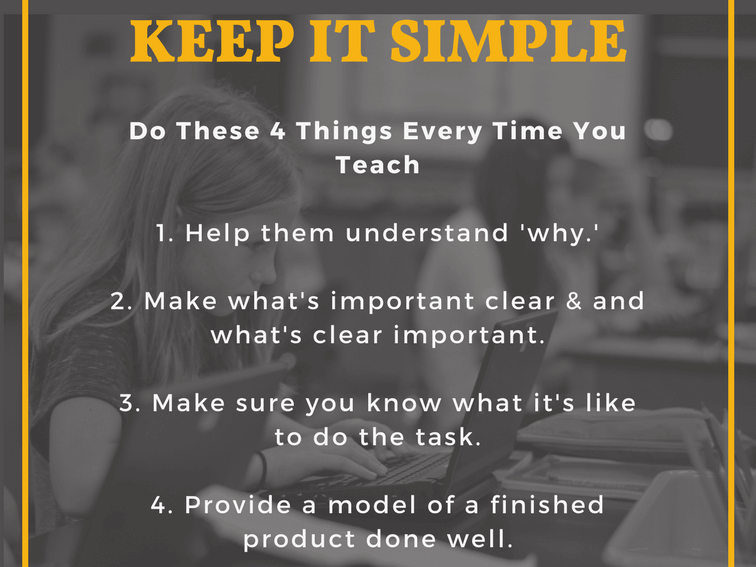
You Should Do These 4 Things Every Time You Teach
by Jeffrey Benson
ed note: This post has been updated
It happens a million times a day in schools: a teacher starts a lesson.
The strong students seize on the new learning opportunity. Typical students figure out enough of what they have to do to succeed. But students who struggle in school may flare up, or shut down, at this critical juncture. These challenging students often react before they give themselves a chance.
There are many unpredictable ways your new lesson can trigger an old wound in a challenging student. Teachers can reduce those sudden negative reactions by planning to provide directions in four ways. These approaches are good for every student and probably necessary for our most vulnerable ones.
Keep It Simple: Do These 4 Things Every Time You Teach
1. Help them understand ‘why.’
And have a good reason. Sell the students on the purpose and importance of the task.
Challenging students need your honesty, and they need your passion. “This lesson is going to help you improve your writing.” “This lesson has some of the most interesting information on evolution you’ll ever see.” “I am so excited today that you are going to work on ratios. I love doing them. They are like little puzzles that you can solve.”
If the only reason you are teaching the lesson is because some mysterious “they” put it on the curriculum, our vulnerable students won’t care either. They need you to show you care first.
2. Make what’s important clear & and what’s clear important.
Give the traditional, step-by-step directions. Don’t just say them—write them on the board, project them, give copies that students can reference and keep in binders.
Also, don’t give too much information–what’s important should be very clear, but that which is most clear should be limited to what’s most important.
For many students with processing weaknesses, words are like helium balloons that float away if they are not quickly tied down, so tie down those directions! I embellish mine with very primitive stick figures, arrows, balloons, and underlining. My students smile at me and pay attention.
3. Make sure you know what it’s like to do the task.
We learn so much from watching artists, athletes, and cooks do their work; you can demonstrate the work, too.
Sit among the students and start the work in a dramatic and exaggerated fashion, narrating your moves: “Okay, I’ve got to write this essay. Where’s my dictionary? I need my dictionary. OK, I put it nearby. Let me reread the directions. What’s the point of this task? Oh yeah, I have to…”
Sometimes you can predict where they will encounter problems and make a show of that: “I want to give up! I am so bad at this! Where’s the teacher? I need help. Okay, I better raise my hand…”
4. Provide a model of a finished product done well.
This may be the most important of all four steps. Too often, students do not know what we want from them. Most adults, when assembling a piece of furniture, continually refer back to the picture on the box.
This allows us to work from whole-to-part-to-whole-to part, so necessary for many tasks and impossible to do without a clear image of the final product. Every time you give out a worksheet, give out a sample of one completed with excellence.
There are many reasons that challenging students fail to engage.
No one action you take will magically eliminate their fear and avoidance, but providing a wide-open front door into a lesson every time will always be a best practice.
Jeffrey Benson has worked in almost every school context in his 35 years as an educator, from elementary school through graduate programs. He has been a consultant to public and private schools, mentored teachers and principals in varied school settings, and has written on many school-based issues. Benson’s new book, Hanging In: Strategies for Teaching the Students Who Challenge Us Most (ASCD, 2014), shows educators the value of tenacity and building connections when teaching the students who most need our help.
4 Ways To Keep Students From Giving Up Before They Even Begin; image attribution flickr user flickeringbrad